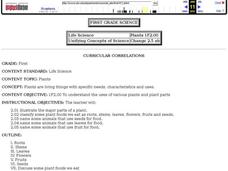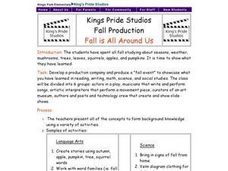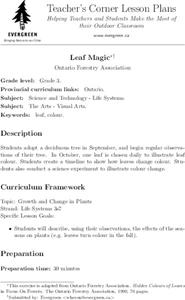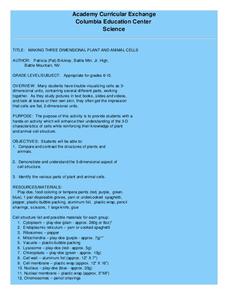Curated OER
Leaf Unit
Students complete a unit on leaves and their functions. They identify leaves and the trees they belong to, read various books, observe the process of photosynthesis on a flannel board, and create a leaf collage.
Curated OER
Plants
Students illustrate the major parts of a plant, classify some plant foods we eat as roots, stems, leaves, flowers, fruits and seeds. They also name some animals that use seeds, leaves, and fruit for food.
Curated OER
Fall is All Around Us
Learners develop and create a production company and produce a fall event that demonstrates what they have learned in various subject areas. STudents create stories, complete a venn diagram comparing fall and summer, graph and measure...
Curated OER
Multi-Color Leaf Prints
Students create multi-color leaf prints. Using different shapes and sizes of leaves, they trace them onto a plate and cut it out after adding the veins. They color it with one color and turn it over to make a print and repeat the...
Curated OER
Leaf Identification
Students identify different leaf types. They examine their patterns, shapes and colors. They complete a worksheet to end the lesson.
Curated OER
Where Does the Green Go?
Students investigate why green leaves change colors in the fall. They press leaves and write a poem, create a chlorophyll leaf print, take a nature walk, and create a leaf shape poster.
Curated OER
Learning From Leaves: A Look at Leaf Size
Pupils measure and analyze leaves from various environments. They discuss the environments, and make inferences about environmental variables that could have contributed to the differences in leaf size and texture.
Curated OER
Learning From Leaves: From Observation to Inference
Young scholars examine the adaptation of plants to their environments. They analyze and observe the structure, shape, and internal structure of various leaves, and make inferences about the structures.
Curated OER
Learning From Leaves: Adaptations To Differing Light Levels
Students, in groups, examine plants with different light levels. They are given plants from a tropical and desert region. They write a hypothesis at the beginning of the experiment.
Curated OER
Leaf - It's What's for Dinner
Students discover correlations in food preferences of invertebrates, and assess stream health through use of kicknets, invertebrate keys, CBL systems and probes.
Curated OER
Glucose Factory
Fourth graders determine, through laboratory activity, the presence or absence of glucose in a variety of plant leaves and stems. They work in groups and perform a three part laboratory which shows them how plants convert sunlighht to food.
Curated OER
Leaf Magic
Third graders adopt a deciduous tree in September, and begin regular observations of their tree. They create a timeline to show how leaves change color and conduct a science experiment to illustrate color change.
Alabama Learning Exchange
Why Roots, Stems, and Leaves are Important
Young scholars use the Internet to research the importance of leaves, stems and roots to plants. They participate in a hands-on experiment to identify the functions of different plant parts.
Curated OER
Hidden Colors
Students discover presence of different colors hidden in green leaves by performing a chromatography experiment on chopped green leaves.
Curated OER
Edible Plants
Students determine what part of a plant they are eating when they eat different fruits and vegetables.
Curated OER
Making Three Dimensional Plant and Animal Cells
Young scholars use a hands-on activity which enhance their understanding of the 3-D characteristics of cells while reinforcing their knowledge of plant and animal cell structure.
Curated OER
Autumn Learning Fun
Learners discuss autumn. In this language arts lesson, students discuss words that are associated with the season of autumn. Learners read books about autumn.
Curated OER
All About Plants
Students identify plant needs. In this biology lesson, students watch All About Plants and then write a paragraph describing the various details about plants.
Curated OER
Tree Identification
In this tree identification worksheet, students collect samples from different trees and identify them using the deciduous tree guide or the conifer key.
Curated OER
Fall Leaves
In this leaf press worksheet, students glue or draw a picture of a tree in the left column. Students then press a leaf between sheets of newspaper and heavy books. When dry, students glue the leaf in the right column. Students than...
Curated OER
How Do Plants Carry Out Life Processes?
In this plants worksheet, students write in how a plant's leaves, roots, and stems help it to live. This worksheet is a graphic organizer.
Curated OER
How Can Plants Be Sorted?
For this plant classification worksheet, learners will observe a variety of different plants and categorize each plant by its flowers, leaves, and spines. This worksheet had 13 fill in the blank questions.
Curated OER
Fall Puzzle
In this fall setting worksheet, students locate five fall terms going in a variety of different directions in a word search puzzle.
Curated OER
Leaf Observations
Second graders examine a variety of leaves. In groups or individually, they write down their observations on each leaf type and compare them to each other. To end the lesson, they share their observations with the class and draw the...

























